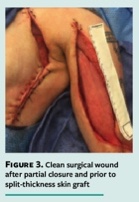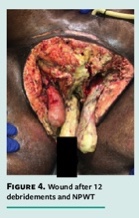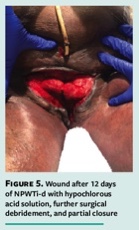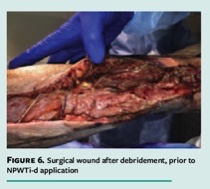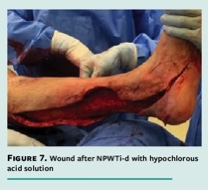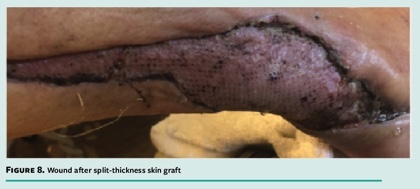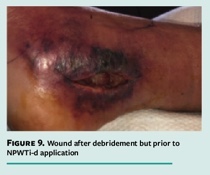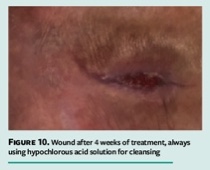ADVERTISEMENT
Healing Complex Wounds From Necrotizing Fasciitis Using the Combination of Negative Pressure Wound Therapy With Instillation and Dwell and a Hypochlorous Acid Solution
Introduction
A retrospective chart review was performed to obtain patient information. All patients received systemic antibiotics in addition to prescribed wound therapy, underwent debridement as necessary, were treated with NPWTi-d, instilling hypochlorous acid solution during wound treatment, and had dressings changed at 48- to 72-hour intervals.
Case Reports
Case 1 (Figure 1, Figure 2, Figure 3). A 29-year-old woman with a history of intravenous drug use was admitted with necrotizing fasciitis of the left arm and chest. Treatment during the first week of the hospital stay included 5 operating room (OR) trips for debridement and local wound care with packing gauze soaked in Dakin’s solution (Century Pharmaceuticals). Following that, NPWTi-d with hypochlorous acid solution was applied for ongoing wound management. No further debridements were needed, and the wound underwent definitive closure within 6 weeks of admission.
Case 2 (Figure 4 and Figure 5). A 73-year-old man, who was admitted with Fournier gangrene, underwent 12 OR debridements and NPWT dressing changes. NPWTi-d with hypochlorous acid solution was used for 12 days. Care was transitioned to bedside wound packing changes with hypochlorous acid solution-soaked gauze after partial wound closure.
Case 3 (Figure 6, Figure 7, and Figure 8). A 56-year-old man with a history of diabetes mellitus and alcoholism was admitted with left leg necrotizing fasciitis. He underwent extensive surgical debridement with PVP/iodine (Betadine; Avrio Health) packing ×3 in the first 72 hours of his admission. At the third debridement, NPWTi-d with hypochlorous acid solution was placed in the OR. The patient underwent dressing change and wound examination in the OR 48 hours later. The wound base had improved greatly, and an extracellular matrix with PHMB (Puraply; Organogenesis Inc.) was applied followed by NPWT. The patient returned to the OR 72 hours later for primary closure.
Case 4 (Figure 9 and Figure 10). A 60-year-old man with a history of squamous cell cancer of his right leg after Mohs surgery 1 month prior was admitted with necrotizing fasciitis of the right leg. He underwent excisional debridement of the ankle and thigh, and NPWTi-d with hypochlorous acid solution was placed. After 72 hours, care transitioned to hypochlorous acid solution soaks before NPWT application at home. His wounds healed within 6 weeks.
Conclusion
These cases highlight the synergistic effect that the combination of NPWTi-d with a hypochlorous acid solution as the instillation solution can have. The combination improved clinical outcomes and resulted in wound healing and closure. Each case involved a complex wound and often a complex patient with comorbidities who was faced with a limb- and life-threatening infection. Each patient showed clinical improvement with the initiation of NPWTi-d with hypochlorous acid solution in addition to intravenous antibiotics; all survived the condition, albeit after long stays in the intensive care and stepdown units. A pH-controlled pure hypochlorous acid solution offers a promising way to manage necrotizing fasciitis, particularly in combination with NPWTi-d. These results mirror those of another study in a similar acute care setting.4
Pearls for Practice is made possible through the support of Urgo Medical, Fort Worth, TX (www.urgomedical.com). The opinions and statements of the clinicians providing Pearls for Practice are specific to the respective authors and not necessarily those of Urgo Medical, Wound Management & Prevention, or HMP Global. This article was not subject to the Wound Management & Prevention peer-review process..
References
1. Singh G, Bharpoda P, Reddy R. Necrotizing fasciitis: a study of 48 cases. Indian J Surg. 2015;77(suppl 2):345–350.
2. Muqim R. Necrotizing fasciitis: management and outcome. J Coll Physicians Surg Pak. 2003;13(12):711–714.
3. Livingstone JP, Hasegawa IG, Murray P. Utilizing negative pressure wound therapy with instillation and dwell time for extensive necrotizing fasciitis of the lower extremity: a case report. Cureus. 2018;10(10):e3483. doi:10.7759/cureus.3483
4. Alberto CE, MD, Cardenas L, Cipolle M, Gallagher KE. Level 1 trauma center experience utilizing negative pressure wound therapy with instillation: hypochlorous acid versus normal saline solution in complex or infected wounds. J Med Sci Clin Res. 2020;8(6):414-420.
Pearls for Practice is made possible through the support of Urgo Medical, Fort Worth, TX (www.urgomedical.com). The opinions and statements of the clinicians providing Pearls for Practice are specific to the respective authors and not necessarily those of Urgo Medical, Wound Management & Prevention, or HMP Global. This article was not subject to the Wound Management & Prevention peer-review process.







